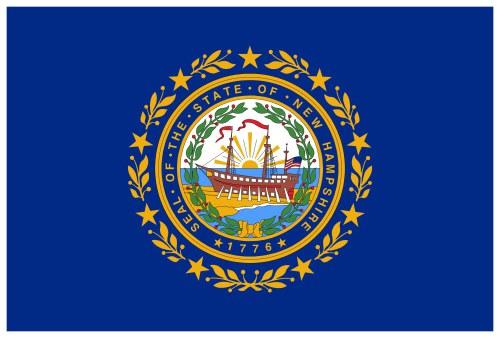
Flag of New Hampshire, USA
January
Weather in January
January is the coldest month of the year in New Hampshire and is marked by a stark contrast between its northern and southern regions. The northern wilderness often experiences temperatures below 0°F (-17.8°C), while the southern parts have average lows ranging from -4°F (-20°C) to 15°F (-9.4°C). In comparison to the milder temperatures of December, January sees a significant drop, and the frigid weather persists into February.
Mount Washington, part of the state's famed White Mountains range, is notable for recording some of the lowest temperatures, including the state's lowest of -47°F (-43.9°C) on January 29, 1934. Snowfall during this month is heavy, contributing to the overall accumulation of 60" (1524mm) to 100" (2540mm) statewide, with even higher amounts in the mountainous regions.
Strong arctic winds sweep across the northern areas, while the mountain ranges help protect the southern region from these cold fronts. The Atlantic Ocean's influence moderates temperatures in the southeastern part, but the overall climate remains cold and icy, characterized by frequent snowstorms. Skiing and snowboarding enthusiasts will find the state's northern regions particularly appealing during this time, as they are some of the best places in the country for winter sports.
Mount Washington, part of the state's famed White Mountains range, is notable for recording some of the lowest temperatures, including the state's lowest of -47°F (-43.9°C) on January 29, 1934. Snowfall during this month is heavy, contributing to the overall accumulation of 60" (1524mm) to 100" (2540mm) statewide, with even higher amounts in the mountainous regions.
Strong arctic winds sweep across the northern areas, while the mountain ranges help protect the southern region from these cold fronts. The Atlantic Ocean's influence moderates temperatures in the southeastern part, but the overall climate remains cold and icy, characterized by frequent snowstorms. Skiing and snowboarding enthusiasts will find the state's northern regions particularly appealing during this time, as they are some of the best places in the country for winter sports.
- Manchester - January »
In Manchester in January, snow falls for 7.1 days, with typically accumulated 2.4" (61mm) of snow. In Manchester, in January, during 7.1 snowfall days, 2.4" (61mm) of snow is typically accumulated. - Nashua - January »
In Nashua, in January, snow falls for 6.5 days, with typically accumulated 1.1" (28mm) of snow. January in Nashua, New Hampshire brings chilly weather with average high temperatures reaching 30.9°F (-0.6°C), while the mercury drops as low as 18°F (-7.8°C) during the evening hours. - Concord - January »
In Concord, in January, during 10.8 snowfall days, 7.09" (180mm) of snow is typically accumulated. In Concord, in January, snow falls for 10.8 days, with typically accumulated 7.09" (180mm) of snow. - Derry - January »
The month with the least rainfall in Derry is January, when the rain falls for 4.1 days and typically collects 0.75" (19mm) of precipitation. In Derry, New Hampshire, during January, snow falls for 7.1 days and regularly aggregates up to 2.4" (61mm) of snow. - Dover - January »
In Dover, New Hampshire, during January, snow falls for 7.4 days and regularly aggregates up to 3.35" (85mm) of snow. In Dover, during January, snow falls for 7.4 days and regularly aggregates up to 3.35" (85mm) of snow. - Rochester - January »
In Rochester in January, snow falls for 10.4 days, with typically accumulated 6.26" (159mm) of snow. In Rochester, in January, snow falls for 10.4 days, with typically accumulated 6.26" (159mm) of snow. - Salem - January »
In Salem in January, snow falls for 8.5 days, with typically accumulated 3.46" (88mm) of snow. January in Salem, New Hampshire initiates the year with abundant cloud cover and a fair share of snowfall, comprising a snowfall of 3.46" (88mm) across 8.5 days. - Merrimack - January »
In Merrimack, in January, during 7.1 snowfall days, 2.4" (61mm) of snow is typically accumulated. On the first day of January in Merrimack sunrise is at 7:16 am and sunset at 4:22 pm. - Londonderry - January »
In Londonderry in January, during 7.1 snowfall days, 2.4" (61mm) of snow is typically accumulated. In Londonderry, during January, snow falls for 7.1 days and regularly aggregates up to 2.4" (61mm) of snow. - Keene - January »
In Keene during January, snow falls for 9.2 days and regularly aggregates up to 2.64" (67mm) of snow. In Keene, January is the month with the lowest recorded average temperatures, measuring a high of 27.9°F (-2.3°C) and a low of 15.1°F (-9.4°C). - Bedford - January »
The month with the least rainfall in Bedford is January, when the rain falls for 4.1 days and typically collects 0.75" (19mm) of precipitation. January proves to be the coldest month in Bedford, New Hampshire, recording an average maximum temperature of 30.6°F (-0.8°C) and a minimum temperature of 18°F (-7.8°C).
Updated: May 24, 2024
Published by: Weather U.S. | About Us
Data Sources | Weather Forecasting & Climate
Published by: Weather U.S. | About Us
Data Sources | Weather Forecasting & Climate